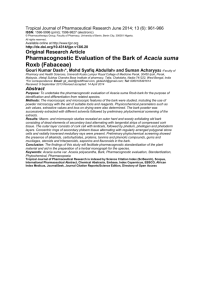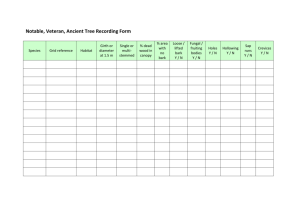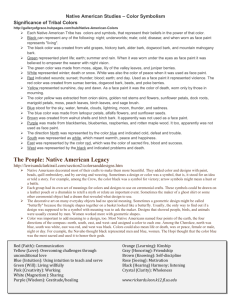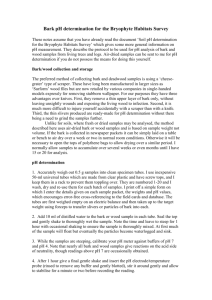An Ancient Writing Material: Birch-Bark and its Need of Conservation
advertisement
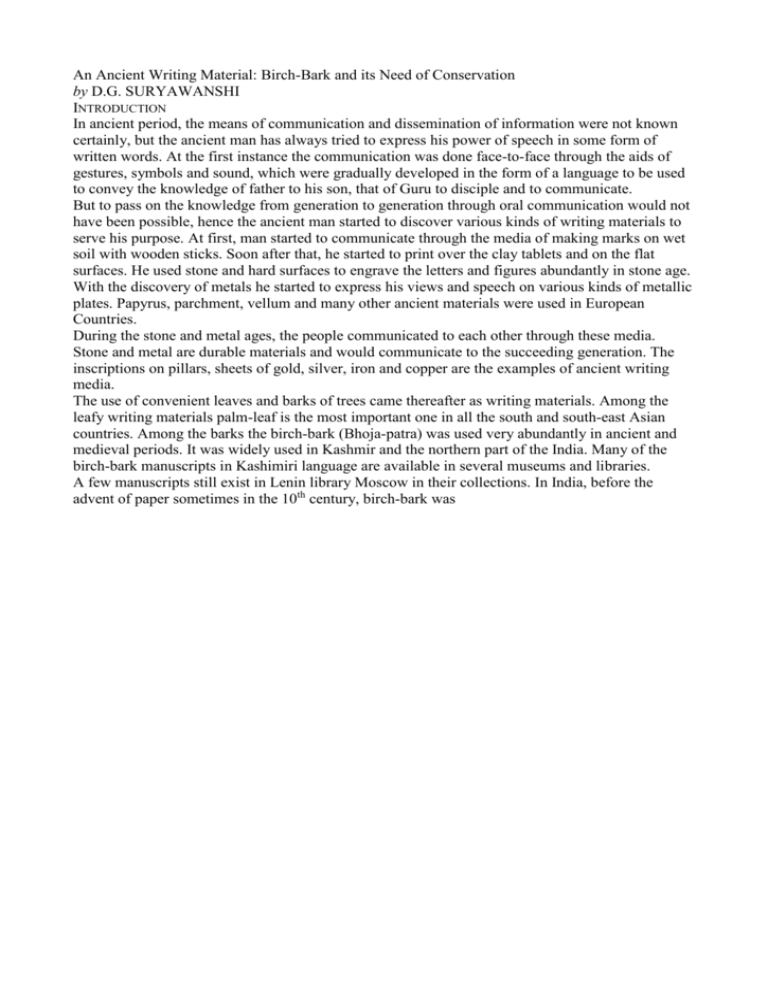
An Ancient Writing Material: Birch-Bark and its Need of Conservation by D.G. SURYAWANSHI INTRODUCTION In ancient period, the means of communication and dissemination of information were not known certainly, but the ancient man has always tried to express his power of speech in some form of written words. At the first instance the communication was done face-to-face through the aids of gestures, symbols and sound, which were gradually developed in the form of a language to be used to convey the knowledge of father to his son, that of Guru to disciple and to communicate. But to pass on the knowledge from generation to generation through oral communication would not have been possible, hence the ancient man started to discover various kinds of writing materials to serve his purpose. At first, man started to communicate through the media of making marks on wet soil with wooden sticks. Soon after that, he started to print over the clay tablets and on the flat surfaces. He used stone and hard surfaces to engrave the letters and figures abundantly in stone age. With the discovery of metals he started to express his views and speech on various kinds of metallic plates. Papyrus, parchment, vellum and many other ancient materials were used in European Countries. During the stone and metal ages, the people communicated to each other through these media. Stone and metal are durable materials and would communicate to the succeeding generation. The inscriptions on pillars, sheets of gold, silver, iron and copper are the examples of ancient writing media. The use of convenient leaves and barks of trees came thereafter as writing materials. Among the leafy writing materials palm-leaf is the most important one in all the south and south-east Asian countries. Among the barks the birch-bark (Bhoja-patra) was used very abundantly in ancient and medieval periods. It was widely used in Kashmir and the northern part of the India. Many of the birch-bark manuscripts in Kashimiri language are available in several museums and libraries. A few manuscripts still exist in Lenin library Moscow in their collections. In India, before the advent of paper sometimes in the 10th century, birch-bark was Fig. 1: Birch bark, separated in two layers. used for writing purposes. The use of birch-bark was continued till the Mughal period and is being used today also for some purpose injammu and Kashmir1,2. Large collections of manuscripts are found in many Kashmiri houses. BIRCH BARK The bark is a natural, plant-origin organic product which is largely composed of many constituents. It gives very little resistance towards the atmospheric conditions and destructive agents. With the course of ageing, it is considerably decomposed; hence its protection is essential. Origin of birch tree The birch is a native of the colder regions of Europe and Asia, and throughout the whole of Russia, it is more common than any other tree being found in every wood. In the warmer countries it is found at high elevation in the mountains. In India it is found at the altitude of about more than 4000 m (14000 ft.) in Himalayas3. It varies in character according to the temperature. The birch is a moderate sized deciduous tree, belonging to a natural order of Amentaceae under class monoecia and order polyandria4. The bark of the birch-tree is more durable than the wood. When the soil is very scanty, the trees are liable to be blown down, the bark remaining like a hollow cylinder without any symptoms of decay. There is a number of species of birch tree, such as Betula utilis, the yellow birch (Betula luta), the habitat of which ranges from New England and the U.S. lake stages to Georgia, and the black birch (Betual lenta) which has a more restricted distribution. The white or paper birch (Betula papyrifera) is a more northern tree, found from the species of birch tree available at the sites of Himalaya and named as Himalayas silver birch5. The highlanders of Scotland make their houses, beds, chairs, tables, dishes and spoons out of birch wood. Anatomy of birch bark In everyday language the term "bark" means the outer part of the stem and branches which surrounds the wood. From the anatomical point of view, the concept "bark" includes all the tissues which are outside of the cambium6. The bark is divided into two kinds "inner bark" and the "outer bark". The function of the inner bark is to transport the nutrients and to serve as a storage organ for food reserves, whereas the outer bark principally consists of dead tissues and is thus physiologically inactive and only forms a protective layer against mechanical and chemical injuries. In the case of birch the lignified tissues of the inner bark constitute 20.3% of the whole. They are composed of scleren-chymatous tissue. The cork tissue formed from the phellogen outward consists of scale-like cells, the cork cells, arranged in radial rows7. These cells are cemented together by means of an alkali soluble substance. This type of structure constitutes the cork tissue and makes it difficult to be penetrated by water and gases. The walls of cork cells which are very thin and rarely pitted, consist of three layers, the outermost composed of lignified cellulose with an intermediate supersized lamella. In some other tree species (all birch), the walls of the cork cells also contain, in addition to suberin, a substance called betulin which gives die bark its white colour. The cork cells die at a very early stage and become filled with air, primary cork which for several years covers both branches and stem, grows very diick in some species and differentiates into successive layers, some being tighter and other looser. The separation of the different layers is due to the fact that cork cells formed in the late summer have thick walls and are more compressed that those formed in the spring. In the cork tissue, there are areas that allow the penetration of air into the living bark tissue. These mostly roundish, limited spots, where the cork cells are not completely cemented together, are named lenticells8. The cortex tissue is mainly composed of thin walled parenchymatous cells, separated by large intercellular spaces; these cells in many cases lignify and become to resemble scleroid cells. Cortex tissue may also include resin canals or "secretary" cells. Between the cortex and the epidermis or periderm there is often a zone composed of collenchymatous or collenchyma like cells. In certain trees like Betula papyrifera (white-birch) the cortex tissue still persists when the stem has completely matured9. Process of bark removal For removing die bark from the tree, two circular incisions are made quite through the bark several feet from each other. Two verticals incisions are then made on opposite sides of the tree after which a wooden wedge is introduced by which the bark is easily detached in plates usually 10 or 12 feet long and 2-9 inches broad. Utility of birch-bark and its essential oil The thin white bark of the common birch, which peels off like paper is highly inflammable and will burn like a candle. It contains an oil which can be extracted. In Russia it is used in the preparation of Russian leather10, 11. The extraction process works as follows: The white bark, either from freshly cut or decayed trees which are found in the wood, is pressed into a big cone-shaped vessel having a hole compared to a funnel, covered with turf and heated. The oil which trickles down inside this vessel is collected in a bottle or a jug placed under its hole and then stowed away in casks. The purest oil swims at the surface, and when it is rubbed into an animal's skin, it has a tanning effect, changing the skin to be leather, and giving it a typical odour: fragrant for the human nose, but repelling for insects and microorganism. Books bound in Russian leather are not only not liable to become mouldy; they even prevent mouldiness in books which happen to be near to them. Birch bark or its oil resp., can also be used to prepare a sweet juice, for conditioning wine, preparing root beer, and other purposes. The bark which peels off in characteristic layers finds a use in the manufacture of canoes and fancy articles of various kinds. According to Pliny, the branches of the birch tree were used for making baskets, loops of casks, panels and for preparation of charcoal11. He is mentioning a highly fragrant kind of resin exuding from leaves and young twigs, especially after rain or heavy dew, which has been collected and used as "bitumen"11, 12. The odour arising from it is perceptible to a person passing nearly a tree. CONSERVATION PROBLEMS Separation of thin layers The Birch-bark is composed of several layers, each of which is very thin and joined together by a natural adhesive and by knots and streaks. During ageing, the efficiency of the adhesive is lost and the fixed layers start to separate from each other. Refixing again with the same material is very difficult. This is one of the main conservation problems for birch bark manuscripts and we have attempted to address it. Sticking of sheets With ageing and due to the wrong storage of birch-bark manuscripts, the folios get stuck together. It is very difficult to separate them from each other and if even a slight force is applied a considerable damage can occur. Handling Birch bark objects are considerably weak and must be handled with extreme caution. They have lost their initial flexibility and have become stiff and britte. It can happen that such sheets even with slight lifting crumble into pieces. Cleaning Birch bark is a natural organic product of vegetable origin, which is compounded with many constituents like cellulose, lignin, gum, resins and many other unknown products. Therefore, its cleaning with organic solvents is highly problematic, because the solvent can leach out some of the components which may be protective to the bark. Removal of acidity Acidity is an insidious foe to documents of any kind, and though its removal is possible in paper up to some extent, it is very difficult for birch-bark. Alkaline substances affect the band structure between the layers of bark and, as a result of a relevant treatment, they will be separated from each other. Rejoining is very difficult, as already reported. Rejoining separated layers Aqueous solution of methyl cellulose (Glutofix™600) in very low concentration (1,5-2.5%) is applied with a fine brush. It penetrates through the layers which then must be kept under slight pressure between blotting paper at room temperature. After 3-4 hours they are dry and joint together firmly enough to tolerate gende handling. Other problems Besides these, there are many other problems with birch-bark manuscripts, comparable to the problems with palm leaf and even more to those with papyrus. Hardly anything can be done against discolouration, fading of inks, etc. Curled edges can be carefully flattened; indirect moistening before doing so may help to prevent a break. Tears can be repaired in the same manner as it is done with paper, but the result will hardly be as inconspicuous as a good result in paper. For storage and exhibition birch bark that has become brittle should be mounted un- der or between transparent plates (acrylic glass, polycarbonate), if already broken to pieces, then positioned in an exactly custom-made frame of paper of the same thickness as the bark, in order to prevent the pieces from slipping. CONCLUSION Birch-bark manuscripts are not easily affected by insects and fungus and are not perishable under the normal atmospheric conditions of a good room climate. This is due to some organic constituents which are repellent to the insects and fungus. This unique property of birch bark encourages the scientist to go to detailed physico-chemical studies. ACKNOWLEDGEMENTS The author is very thankful to the NRLC Library staff, especially to Mr. Deven-dra Kumar who helped in finding the references. SUMMARIES An Ancient Writing Material: Birch-Bark and its Need of Conservation Birch bark has been used for many purposes, one of them being as writing material. In India it was common until the advent of paper in the 10th century, continued to be used till the Mughal period (16th century), and in Kashmir it is still used for some purposes until today. The structure of the bark and the process to prepare it for writing is described. The main conservation problems are separation of the several layers and brittleness. Separated layers can be rejoined using methyl cellulose in very low concentration. Brittle sheets should be mounted under or between transparent plates of acrylic glass or poylcarbonate. As a result of wrong storage it can happen that several sheets stick together and can hardly be separated without the risk of damage and loss. Un ancien materiau utilise comme support pour I'ecriture : Vecorce de bouleau et les moyens qu 'exige sa conservation L'ecorce de bouleau a ete utilisee a des fins multiples dont celui de support pour I'ecriture. En Inde son utilisation etait courante jusqu'a l'avenement du papier au lOeme Siecle, son utilisation a dure jusqu'a l'Empire Moghol (16eme Siecle) et au Cachemire on s'en sert encore aujourd'hui a certaines occasions. On decrit la structure du bouleau ainsi que le processus de preparation necessaire pour le ren-dre apte a servir de support pour I'ecriture. Les principaux problemes rencontres au niveau de la conservation resident dans la separation des differentes couches et leur fragilite. Il est possible de reassembler les couches qui se detachent a l'aide de cellulose de methyle dans une solution aqueuse fortement diluee. Les feuilles cassantes devraient etre montees sous ou entre des plaques (pellicules) transparentes de verre acrylique ou de polycarbonate. En cas d'entreposage inadapte il se peut que plusieurs feuilles se collent les unes aux autres de telle sorte qu'il est presque impossible de les detacher les unes des autres sans risquer de les deteriorer ou de les detruire. Ein historischer Beschreibstoff: Birkenrinde und ihre konservatorischen Anforderungen Birkenrinde wurde für manche Zwecke verwendet, u.a. als Beschreibstoff. In Indien war sie bis zum Aufkommen des Papiers im 10. Jh. allgemein üblich, stand neben Papier bis in die Mogul-zeit (16. Jh.), und in Kaschmir wird sie für bestimmte Zwecke bis heute eingesetzt. Es werden der Aufbau der Rinde und die Maßnahmen beschrieben, die notwendig sind, um aus ihr einen Beschreibstoff zu machen. Die Hauptprobleme der Konservierung sind die Tren-nung der einzelnen Schichten und das Brüiichigwerden. Getrennte Schichten kann man mit Hilfe von Methylcellulose in stark verdiinnter wäßriger Lösung wieder zusammenfügen. Brüchige Blätter sollten unter oder zwischen transparenten Platten aus Acrylglas oder Polycarbonat montiert werden. Bei falscher Lagerung können die einzelnen Blätter so miteinander verkleben, daß sie sich kaum ohne Beschädigungs- und Verlustgefahr wieder voneinander trennen lassen. REFERENCES 1. Agarwal, O.P.: Conservation of manuscripts and paintings of South-East Asia 7. London: Butter-worth 1984: 11-13. 2. Agarwal, O.P.: Birch bark manuscripts. Museum 27 (1975): 166. 3. Brandis, D.: Indian trees. Dehradum: Bishem Singh Mahendra Pal Sing 1971: 622. 4. Rendle, Alfred Barton: The classification of flowering plants 2. Ghaziabad: Vikas 1979: 24-29. 5. Singh, Gurcharan, & P. Kachroo: Forest flora of Srinagar: Betula Utilis. Denradun: Bishen Singh Manencra Pal Singh 1976: 58. 6. Chang, Y.P.: Anatomy of common North American pulp wood barks. Tappi Monograph Series 14 (1954): 58. 7. Esau, K.: Plant anatomy. New Delhi: Wiley Eastern 1974: 348. 8. Roth, Ingrid: Structural patterns of tropical barks. Encyclopaedia of Plant Anatomy. Berlin: Bornträger 1981: 112. 9. Browning, B.L.: The chemistry of wood. Huntington, NY: Robert E. Krieger 1975: 600, 604. 10. Dastur,J. F.: Useful plants of India and Pakistan. Bombay: D.B. Taraperevala 1964: 35. 11. Hill, Albert F.: Economic botany. A text book of useful plants and plant products. New Delhi: Tata McGraw-Hill 1972: 68-70. 12. Jenson, W.: Chemical characteristics of bark and wood. Acta Acad. Aboensia, Math., Phys, 16 (1948): 3. D.G. Suryawanshi National Research Laboratory for Conservation of Cultural Property E/3, Aliganj Scheme Lucknow - 226 024 India


